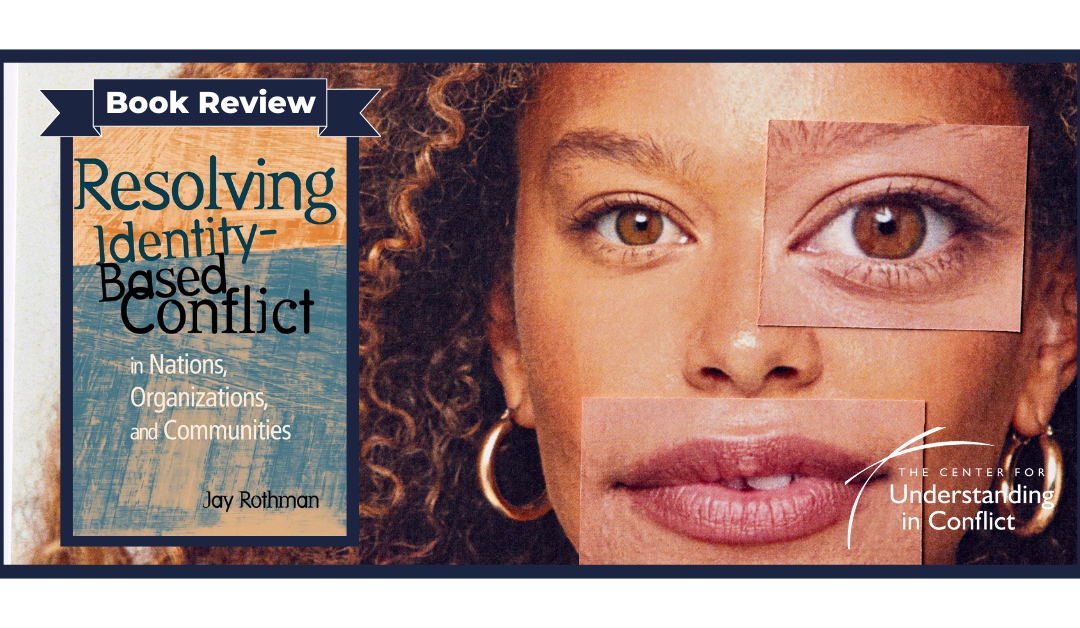Jay Rothman’s Resolving Identity-Based Conflict in Nations, Organizations, and Communities offers a deeply thoughtful and human-centered exploration of conflict rooted in identity. For practitioners of the understanding-based approach, this book is both familiar and expansive. It speaks directly to the core belief that when people in conflict are given the space to genuinely see and be seen, something transformative becomes possible.
Rothman introduces the ARIA model – Antagonism, Resonance, Invention, and Action – as a structured yet flexible pathway for navigating identity-based conflicts. Unlike interest-based models that often emphasize compromise or negotiation around positions, ARIA invites parties to explore what lies underneath: the values, needs, and aspects of identity that drive their experience of conflict. This approach aligns seamlessly with the understanding-based model, which prioritizes going beneath the surface, supporting party ownership, and fostering direct engagement between those in conflict.
The process begins with Antagonism, not as a barrier to resolution but as a necessary entry point. Rothman encourages parties to fully voice their pain and frustration – not in order to escalate, but to clarify. This phase sets the stage for genuine listening and understanding, qualities central to the understanding-based approach. It reflects the view that conflict is not something to be smoothed over too quickly, but something to be explored with care.
Resonance follows, where each side engages with the other’s narrative. This is where the possibility of connection begins. Rothman focuses on empathy as a tool for shifting entrenched perspectives, creating room for mutual recognition even where agreement remains elusive. In the understanding-based approach, this phase might be seen as the moment when the “loop of understanding” takes hold – when the parties begin to feel that their experience is not just being heard, but felt.
Once that relational ground has been laid, the Invention phase allows for co-creating new possibilities. Rothman is clear that solutions arising from this place are fundamentally different from those imposed or brokered by third parties. They reflect not just a resolution to a problem, but a shift in relationship. This emphasis on collaborative agency is a core tenet of understanding-based work, which holds that the people living the conflict are best positioned to resolve it – provided they can access enough understanding, both of themselves and each other.
The final phase, Action, brings the process back into the practical realm. Rothman emphasizes that change must be embodied in real-world steps, not just emotional insight. Agreements reached here are grounded in mutual recognition, increasing the likelihood that they will hold. This echoes the understanding-based model’s emphasis on informed and durable resolution – one that emerges not through pressure, but through clarity and commitment.
Throughout the book, Rothman integrates examples from diverse settings – international negotiations, community dialogues, and organizational tensions – demonstrating the model’s adaptability across contexts. His writing is engaging, warm, and free from jargon, making complex ideas accessible without losing their depth. He approaches identity-based conflict with humility and respect, offering a model that does not pretend to fix people but rather invites them to step into a deeper, more honest conversation.
Professionals familiar with the understanding-based model will recognize many of Rothman’s guiding assumptions: that conflict is not the enemy, that each person’s experience has value, and that meaningful resolution requires confronting difficult truths rather than avoiding them. Yet Rothman’s emphasis on identity brings additional richness. He shows that when people feel unseen or misrecognized at the level of who they are, no amount of technical negotiation will suffice. Healing, and ultimately resolution, comes through processes that honor identity – both one’s own and the other’s.
The book is also notable for its practicality. Rothman includes tools, reflection exercises, and questions that conflict professionals can use in their own settings. These are not scripts or formulas, but resources designed to support deeper inquiry and dialogue. They reflect the same spirit as the understanding-based approach – adaptive, respectful, and focused on empowering the parties.
In a time when identity-based divisions are increasingly pronounced across societies and institutions, Resolving Identity-Based Conflict is an important and timely contribution. It reinforces the idea that conflict, while often painful, is also an opportunity – an invitation to deepen understanding, to recognize the dignity of others, and to create more authentic relationships. For those committed to working through conflict with compassion and clarity, Rothman’s work offers both inspiration and guidance.
